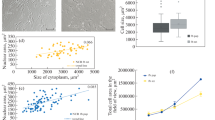Summary
Sections of tendons from the base of the tail of rats were taken at eight time intervals from 18 days in utero until 244 days after birth and were examined in the electron microscope. For each time period, measurements were made of the relative area of fibroblasts, collagen and interstitial material, of the number of fibroblasts per unit area of tendon and of the average area of individual fibroblasts. The spatial arrangement of fibroblasts in the tendon sections was described quantitatively using the “nearest neighbor” method. Initially there was a rapid increase in the area of collagen accompanied by a decrease in the area occupied by fibroblasts but after 104 days of age these values changed very little. The numbers of fibroblasts per unit area decreased steadily from the embryo until 104 days whereas the average size of each cell increased to reach a maximum area at 40 days of age and then declined. At all time intervals cells were arranged in a regular, dispersed pattern across the tendon fascicles. Growth in width of the rat tail appears to involve the secretion of collagen and other intercellular material symmetrically around each fibroblast, so as to gradually separate the cells until a stage is reached at which cells are sufficiently far apart that there is little contact between adjacent cell processes. This may interfere with the integration of metabolic activity in the tissue. As a consequence, there is shrinkage of the cell bodies and a reduction in secretory activity so that, between 55 and 104 days of age, the tendon enters a period of terminal senescence.
Similar content being viewed by others
References
Bausch WH (1980) Spatial relationship between fibroblasts in dense regular connective tissue. M S Thesis, The University of Iowa, Iowa City
Cho MI, Garant PR (1981a) Sequential events in the formation of collagen secretion granules with special reference to the development of segment long-spacing-like aggregates. Anat Rec 188:309–320
Cho MI, Garant PR (1981b) Role of microtubules in the organization of the Golgi complex and the secretion of collagen secretory granules by periodontal ligament fibroblasts. Anat Rec 199:469–471
Clark P, Evans F (1954) Distance to nearest neighbor as a measure of spatial relationships in populations. Ecology 35:445–453
Greenlee TK, Ross R (1967) The development of the rat flexor digital tendon, a fine structure study. J Ultrastruct Res 18:353–376
Ham AW, Cormack DH (1979) In: Histology (8th ed) Philadelphia, J.P. Lippincott Co, pp 231–235, 367–369
Heck T, Hempel K, Lange HW, Romen W (1981) Studies on collagen metabolism in rats. I. Age-related changes in turnover and amino acid composition of the collagen of glomerular basement membrane and tail tendon. Virchows Arch (Cell Pathol) 36:303–311
Holmes I (1971) Variations in tendon cell morphology with animal, site and age. J Anat 108:305–309
Ippolito E, Natali PG, Postacchini F, Accinni L, de Martino C (1980) Morphological immunochemical and biochemical study of rabbit Achilles tendon at various ages. J Bone Joint Surg 62A: 583–598
James NT (1971) A geometrical probability study of type I muscle fibres in the rabbit and guinea pig. J Neurol Sci 14:381–387
James NT (1974) A study of the distribution of mitochondria in some oxidative muscle fibers of the pig. J Neurol Sci 23:565–573
Karnovsky MJ (1965) A formaldehyde-gluteraldehyde feature of high osmolality for use in electron microscopy. J Cell Biol 27:137A
Loewenstein WR (1979) Junctional intercellular communication and the control of growth. Biochem Biophys Acta 560:1–65
Maximow A (1930) In: Bloom W (ed) A textbook of histology. WB Saunders Co, Philadelphia, pp 91–93
Parry DAD, Craig AS (1977) Quantitative electron microscope observations of the collagen fibrils in rat-tail tendon. Biopolymers 16:1015–1031
Parry DAD, Craig AS (1978) Collagen fibrils and elastic fibers in rat tail tendon: an electron microscopic investigation. Biopolymers 17:843–855
Peacock EE (1965) Biological principles in the healing of long tendons. The Surgical Clinics of North America 45:461–476. WB Saunders, Philadelphia
Pitts JD (1980) The role of Junctional communication in animal tissues. In Vitro 16:1049–1056
Ripley BD (1981) Spatial statistics. John Wiley and Sons, New York, pp 152–190
Robert L, Derouette S, Moczar E (1971) Biochemical studies on the aging of rat tail tendon. Gerontologia 17:65–74
Scott JE, Orford CR, Hughes EW (1981) Proteoglycan-collagen arrangements in developing rat tail tendon. Biochem J 195:573–581
Snedecor GW, Cochran WG (1967) Statistical methods. Ames, Iowa, Iowa State University Press
Torp S, Arridge RGC, Ameniades CD, Baer E (1975a) Structure-property relationships in tendon as a function of age. In: Atkins EDT, Keller A (eds) Structure of fibrous biopolymers. (Vol 26 of the Colston Papers) Butterworths, London, pp 197–221
Torp S, Baer E, Fredman B (1975b) Effects of age and of mechanical deformation on the ultrastructure of tendon. In: Atkins EDT, Keller A (eds) Structure of fibrous biopolymers. (Vol 26 of the Colston Papers). Butterworths, London, pp 223–250
Trelstad RL, Hayashi K (1979) Tendon collagen fibrillogenesis; ultracellular subassemblies and cell surface changes associated with fibril growth. Dev Biol 71:228–242
Weibel ER (1979) Stereologic principles. Academic Press, New York
Author information
Authors and Affiliations
Rights and permissions
About this article
Cite this article
Squier, C.A., Magnes, C. Spatial relationships between fibroblasts during the growth of rat-tail tendon. Cell Tissue Res. 234, 17–29 (1983). https://doi.org/10.1007/BF00217399
Accepted:
Issue Date:
DOI: https://doi.org/10.1007/BF00217399




